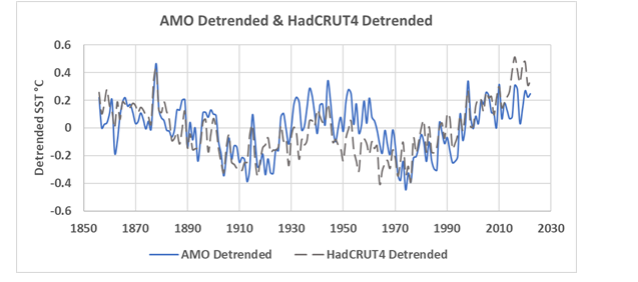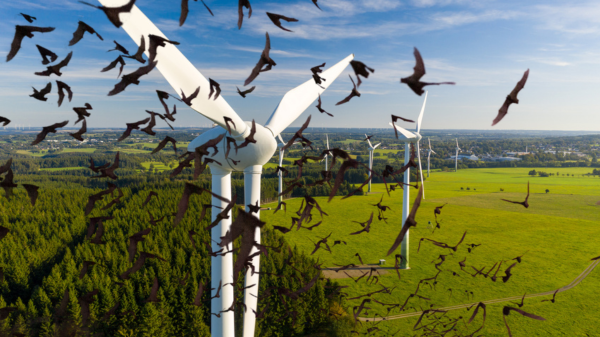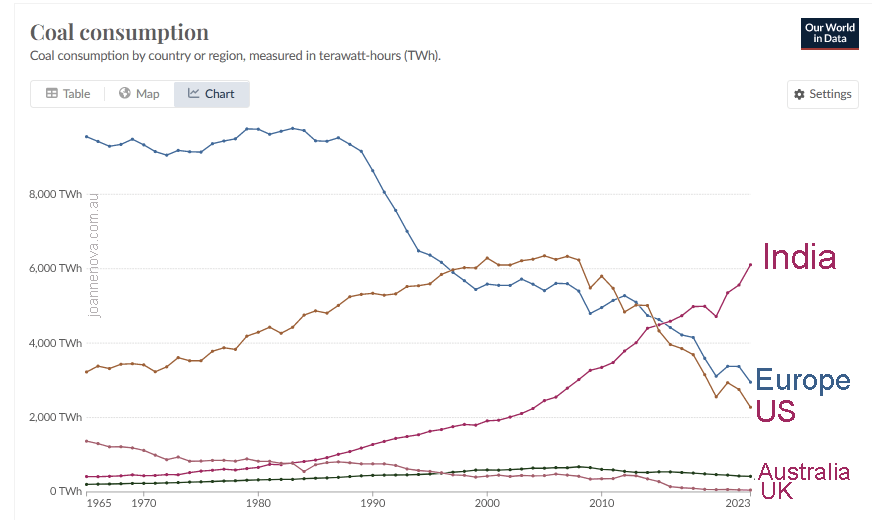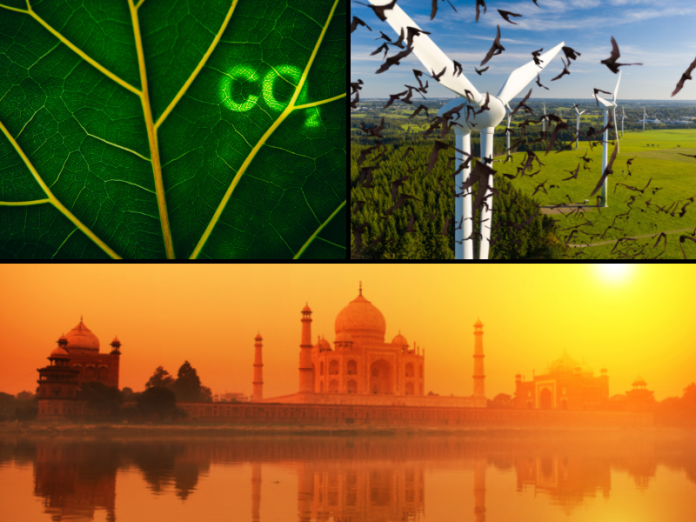YOU SHOULD SUBSCRIBE TO CLIMATE CHANGE WEEKLY.
IN THIS ISSUE:
- Carbon Dioxide Levels and Warming Aren’t a Problem, New Study Says
- Video of the Week: Media Lying About Heatwaves
- German Wind Farms Causing a Batpocalypse
- Podcast of the Week: Climate Alarmist Messaging Decoded: Lies Work (Guest: Steve Milloy)
- India’s Energy Transition Is Apparently on Hold
- Climate Comedy
- Recommended Sites
Watch ALL the Presentations by the ALL-STARS of Climate Realism at the Archive of Heartland’s 15 Climate Conferences
Illegal ESG Collusion Behind Decarbonization Efforts

A new paper published in the peer-reviewed American Journal of Economics and Sociology by petrophysicist Andy May and science journalist Marcel Crok, both with the Climate Intelligence Foundation (Clintel), presents a fact-grounded, well-structured argument indicating the world does not face a climate crisis. Their claims are well-documented with copious footnotes directing readers to the underlying research.
May’s and Crok’s research directly refutes claims made by the Intergovernmental Panel on Climate Change’s (IPCC) Sixth Assessment Report that:
Human-induced climate change … has caused widespread adverse impacts and related losses and damages to nature and people, beyond natural climate variability. … The rise in weather and climate extremes has led to some irreversible impacts as natural and human systems are pushed beyond their ability to adapt (high confidence).
They examine both the claim that we can be certain that humans are mostly or wholly responsible for current climate changes, and that the ongoing climate shift, with modest warming, is causing worsening extreme weather and harm to humans, finding both claims lacking.
The IPCC’s claim that humans are causing climate change rests on two primary pillars: simulations of the climate in general circulation models (climate models) with and without rising CO2 emissions; and claims of an “atmospheric fingerprint” from the differing ways in which the stratosphere, and the middle and lower troposphere are responding to rising CO2 concentrations.
Concerning climate model simulations, May and Crok point out that even the IPCC admits that despite 38 years or more of tinkering and creating new models with updated assumptions about climate sensitivity, the climate models’ projections grossly overestimate surface and ocean temperatures, and that the warming experienced doesn’t track well (in a direct causal fashion) the relatively constant rise in carbon dioxide emissions.
Concerning the “atmospheric fingerprint,” May and Crok point to several lines of evidence that suggest factors other than CO2 can account for the differences in the ways temperature is changing (or not) in different layers of the troposphere and the stratosphere. Some research suggests changes in atmospheric aerosols and the ozone (both with human causes) have impacted the climate, affecting temperatures changes in different ways at different layers of the atmosphere. Other research points to solar activity playing a role in temperature shifts.
The most persuasive evidence May and Crok present that suggests nature is playing a greater role in present climate change than the IPCC admits is their examination of the Atlantic Multidecadal Oscillation (AMO), comparing changes it since 1850 to changes in surface temperatures from the widely used and cited HadCRUT4 global average temperature data set. When the two data sets are overlayed, they match very closely.

Indeed, the data indicates the AMO alone could account for as much as 30 percent of the warming over the past 150 years or so. In addition, the AMO seems to shift in about a 70-year cycle, the most recent shift coinciding with warming since 1980. They modestly conclude that, collectively, these different lines of evidence “cast some doubt on the AR6 claim
that all 20th century warming is due to human influence and there is no net natural impact.”
Regardless of whether humans bear no responsibility, some, or are completely absolved for the recent moderate warming, the evidence clearly shows that, contrary to IPCC assertions, there is no significant worsening in weather extremes or the harms different incidences of extreme weather are causing. They point to data which show conclusively that:
Currently it is very hard to find any unusual weather or weather-related disaster that can be blamed on climate change, whether natural or human-caused, despite constant news media claims to the contrary. … Weather-related disasters occur every year. But the trends in the cost, as a fraction of GDP, or human suffering and death due to them are, respectively, flat or rapidly declining ….
Globally, most damage (around 90%) from extreme weather by far is due to flooding and severe storms, such as tropical cyclones. The most damaging extremes, hurricanes, floods, and (weather-related) droughts have not changed globally on climatic time scales (>30 years). The earth has warmed by slightly more than one degree Celsius, and the CO2 concentration has gone up, but the most dramatic, destructive, and deadly extreme weather events have not changed significantly or have declined. Further, 52 of 53 studies of disaster losses due to extreme weather were unable to attribute the events to human causes, and the one study that did claim human attribution was flawed.
May and Crok point to the IPCC’s own statements to bolster their claims. Concerning flooding, high frequency rain events, and river flows, the IPCC admits, there is “low confidence in the human influence on the changes in high river flows on the global scale… [and] there is low confidence in attributing changes in the probability or magnitude of flood events to human influence. …” And, with annual hurricane numbers and the number of major hurricanes trending downward, the IPCC acknowledges, “…it remains uncertain whether past changes in Atlantic [tropical cyclone] activity are outside the range of natural variability.”
They also point out the fact that despite a quadrupling of world population since 1920, deaths resulting from extreme weather events have fallen by 99 percent.
Hundreds of posts at Climate Realism and dozens of fact sheets posted at Climate at a Glance confirm May’s and Crok’s findings that extreme weather is not becoming more frequent or severe and that lives lost to extreme weather events and non-optimum heat have declined dramatically as the Earth has modestly warmed.
May and Crok proceed to briefly compare modern and past temperatures, and then examine the benefits that climate change, increased CO2, and modest warming are delivering to the world. The latter issue is routinely ignored or downplayed but is of critical importance when understanding whether climate change poses an existential threat and catastrophe for humanity. They write:
There is no doubt that climate change, whether natural or human-caused, will have adverse effects for some people in some locations. However, this overlooks the fact that climate change will benefit other people in different locations. As with any analysis, both the benefits and the costs must be examined; and AR6 clearly only examines the downside risks of climate change. The lack of an analysis of the benefits of climate change damages their credibility as an unbiased observer of the science of climate change.
Sources: The American Journal of Economics and Sociology (behind a paywall); CFACT
NEW: Get Climate at a Glance on your mobile device!
Video of the Week
Heatwaves are becoming neither more frequent nor more severe; and we have the data to back it up.
Read the brutal truth about how battery production for electric vehicles cause immense environmental destruction and human tragedy.
German Wind Farms Causing a Batpocalypse

Research from Germany indicates the huge expansion of industrial wind facilities there has resulted in the direct and indirect deaths of hundreds of thousands of bats. And the problem is only likely to get worse since the government is implementing regulations to speed-up the approval and construction of new wind facilities.
Frankfurter Allgemeine reports that researchers at the German Bat Observatory have found wind farms are killing bats on a large scale, writing:
“According to scientific estimates, around a quarter of a million bats die every year in Germany alone on wind turbines,” says Marcus Fritze. He heads the competence center for bat protection in Saxony-Anhalt and, together with twelve other experts from the German Bat Observatory, has published a scientific study in the journal “Nyctalus” on the effects of accelerating approval procedures for the expansion of wind turbines in Germany. “The situation could get worse, and species such as the greater noctule, the Nathusius’s pipistrelle and the parti-coloured bat may disappear completely from some areas,” the scientist fears.
The number of deaths is likely higher than has been reported for two reasons. First, surveys around wind facilities aren’t conducted daily, yet evidence suggests that if the bat carcasses aren’t found within a day of being killed, predators and scavengers remove and consume the corpses. When researchers from Berlin’s Leibniz Institute for Zoo and Wildlife Research (IZW) “laid out carcasses of the typical size of flying mammals around wind turbines in an experiment, 24 hours later 95 percent of the bait had disappeared without a trace.”
Second, many bats are believed to suffer mortal, internal, injuries from the extreme pressure changes around turbine operations. These bats are believed to fly off only to die days later, in locations distant from the turbines themselves.
The location of turbines makes a difference. Turbines sited in migration routes, of where prey insects breed or shelter were more likely to cause bat deaths. For example,
“We are already seeing a serious decline in particularly affected species such as the common noctule in countries with many wind turbines, such as Schleswig-Holstein and Lower Saxony,” Fritze told Frankfurter Allgemeine.
For example, the IZW’s Christian Voigt, Ph.D., found “that an average of 70, sometimes even 100 bats had died at certain turbines in [August and September alone] … fly[ing] from their summer hunting grounds in northeastern Germany or the Baltic countries to the southwest as far as the Lake Constance region and France from late August onwards.”
Source: Frankfurter Allgemeine
Heartland’s Must-read Climate Sites



Podcast of the Week
A very telling exposé of a meeting between leading “climate communicators” appeared on Twitter last week. In it, pictures of a slideshow mentioned things like: “Worst messages tested: electric cars, Green New Deal, frontline communities, ‘Big Oil lied’, and climate pollution.” Essentially, the meeting described why climate alarmists have failed to capture the public’s attention with their messages. What they discovered is that lies work better than facts! Steve Milloy of junkscience.com has been following and debunking these lies for years.
Subscribe to the Environment & Climate News podcast on Apple Podcasts, iHeart, Spotify or wherever you get your podcasts. And be sure to leave a positive review!
India’s Energy Transition Is Apparently on Hold

India’s rapid economic growth is largely powered by coal-fueled power plants using domestic and imported coal.
Over the past decade, India has added between one and two gigawatts (GW) of new coal-fueled electricity each year. As Jo Nova points out, citing data from “Our World in Data,” India now generates more electricity from coal than North America and Europe combined (see the figure, below)

In 2023, the Indian government upped the ante, ordering the construction of 10 GW of new coal power. Also, despite India pledging recently to achieve net zero by 2070 and get 50 percent of its energy from renewables by 2030, Asia Financial reports that earlier this year the Indian government directed utilities to spend at least $33 billion on equipment to produce and utilize coal in 2024 in order to expand the use of coal for electricity across the coming decade.
In fact, India’s Prime Minister Narendra Modi is calling on the country to build 31 GW of new coal power “in the next 5 or 6 years,” which journalist and blogger Jo Nova points out equals the combined capacity of all the coal and natural gas plants on the Australian National Grid.
“When President Modi wants electrical generation fast, he didn’t say ‘quick, build 50,000 wind mills, with batteries, gas plants, high voltage lines and pumped hydro,’” writes Nova, who also notes that India’s and China’s growth in coal use make emissions reductions planned in the coming years by Australia, the U.K., and all other industrialized nations combined irrelevant from the perspective of atmospheric CO2 concentrations.
Source: Jo Nova; Center on Global Energy Policy; Asia Financial





























